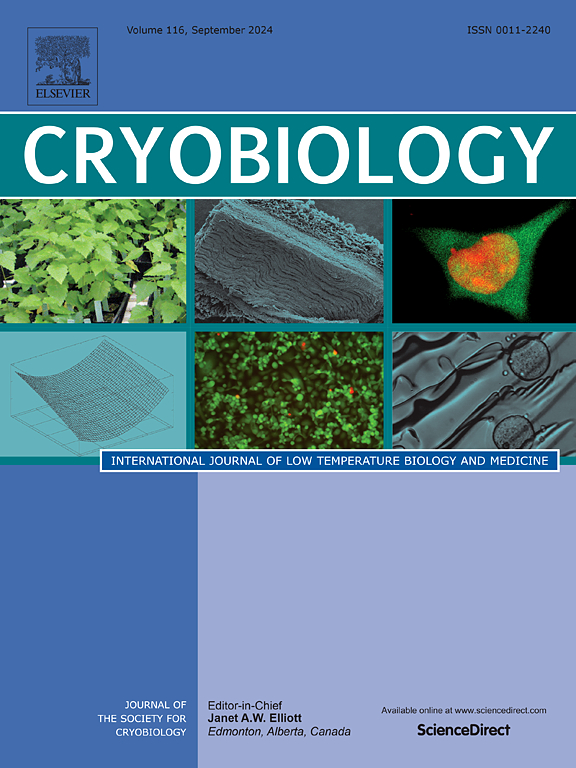细胞骨架对可拉伸表面松弛的适应改善了人类间充质干细胞的粘附冷冻保存。
IF 2.3
3区 生物学
Q2 BIOLOGY
引用次数: 0
摘要
粘附细胞系统在低温保存前通常会被解离,因为标准程序是为悬浮细胞制定的。对于更复杂的、对解离敏感的系统,如粘附单层细胞,特别是由成熟细胞类型或组织组成的系统,标准程序的应用仍不尽人意。在冷冻和解冻细胞单层的过程中,由于细胞内拉伸应力、膜破裂和粘附蛋白受损而导致细胞失控分离的现象十分常见。然而,许多与治疗相关的细胞系统都会粘附生长,形成其原生形态和功能,但在解离后会失去其完整性。我们的假设是,可拉伸基底上的细胞具有更强的细胞骨架和细胞膜适应性,从而减少低温保存引起的应力。我们的研究调查了可拉伸表面对附着细胞低温保存的影响,以避免有害的解离,并加快功能细胞的解冻后培养。我们开发了一种用于确定径向拉伸的拉伸装置,由硅胶容器和具有特定细胞培养表面纹理的薄膜组成。粘附的人脐带间充质干细胞(hUC-MSCs)被培养在容器内拉伸的硅胶薄膜上,形成单层,通过松弛被压缩,同时仍附着在松弛的薄膜上。与未压缩的对照细胞相比,经过压缩的干细胞在解冻后显示出更高的存活率和更少的脱落。在解冻后的三到七天内,hUC-间充质干细胞恢复了活力,单层也重新形成。这些实验支持了一种假设,即粘附细胞系统的低温保存成功率可通过改善细胞骨架和细胞膜的适应性来提高,从而为低温生物技术开辟了新途径。本文章由计算机程序翻译,如有差异,请以英文原文为准。
Cytoskeleton adaptation to stretchable surface relaxation improves adherent cryopreservation of human mesenchymal stem cells
Adherent cell systems are usually dissociated before being cryopreserved, as standard protocols are established for cells in suspension. The application of standard procedures to more complex systems, sensitive to dissociation, such as adherent monolayers, especially comprising mature cell types or tissues remains unsatisfactory. Uncontrolled cell detachment due to intracellular tensile stress, membrane ruptures and damages of adhesion proteins are common during freezing and thawing of cell monolayers. However, many therapeutically relevant cell systems grow adherently to develop their native morphology and functionality, but lose their integrity after dissociation. The hypothesis is that cells on stretchable substrates have a more adaptable cytoskeleton and membrane, reducing cryopreservation-induced stress. Our studies investigate the influence of stretchable surfaces on the cryopreservation of adherent cells to avoid harmful dissociation and expedite post-thawing cultivation of functional cells. A stretching apparatus for defined radial stretching, consisting of silicone vessels and films with specific surface textures for cell culture, was developed. Adherent human umbilical cord mesenchymal stem cells (hUC-MSCs) were cultivated on a stretched silicone film within the vessel, forming a monolayer that was compressed by relaxation, while remaining attached to the relaxed film. Compressed hUC-MSCs, which were cryopreserved adherently showed higher viability and less detachment after thawing compared to control cells without compression. Within three to seven days post-thawing, the hUC-MSCs recovered, and the monolayer reformed. These experiments support the hypothesis that cryopreservation success of adherent cell systems is enhanced by improved adaptability of the cytoskeleton and cell membrane, opening up new approaches in cryobiotechnology.
求助全文
通过发布文献求助,成功后即可免费获取论文全文。
去求助
来源期刊

Cryobiology
生物-生理学
CiteScore
5.40
自引率
7.40%
发文量
71
审稿时长
56 days
期刊介绍:
Cryobiology: International Journal of Low Temperature Biology and Medicine publishes research articles on all aspects of low temperature biology and medicine.
Research Areas include:
• Cryoprotective additives and their pharmacological actions
• Cryosurgery
• Freeze-drying
• Freezing
• Frost hardiness in plants
• Hibernation
• Hypothermia
• Medical applications of reduced temperature
• Perfusion of organs
• All pertinent methodologies
Cryobiology is the official journal of the Society for Cryobiology.
 求助内容:
求助内容: 应助结果提醒方式:
应助结果提醒方式:


